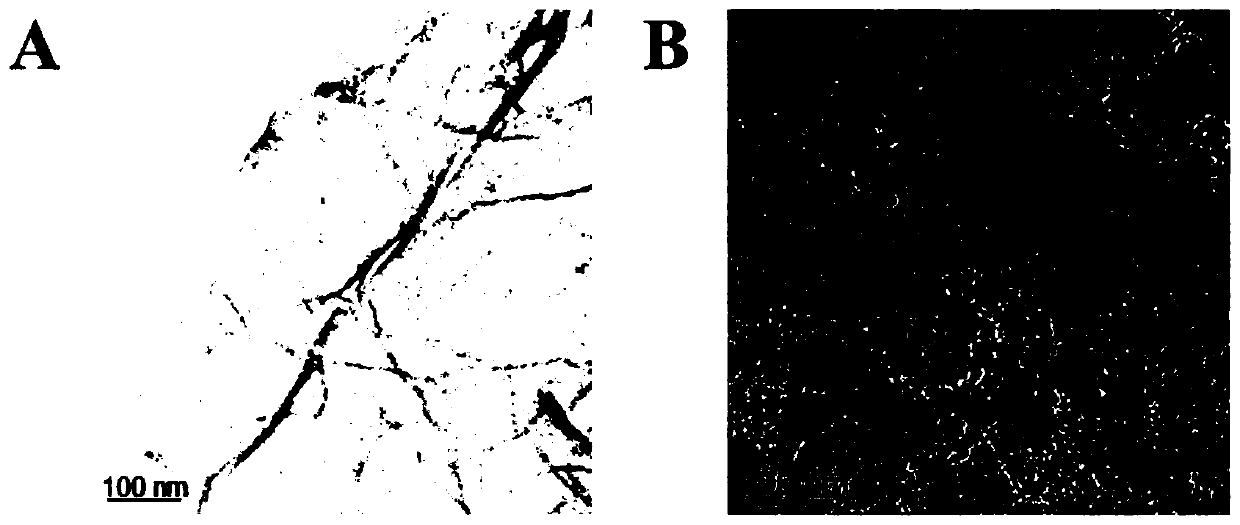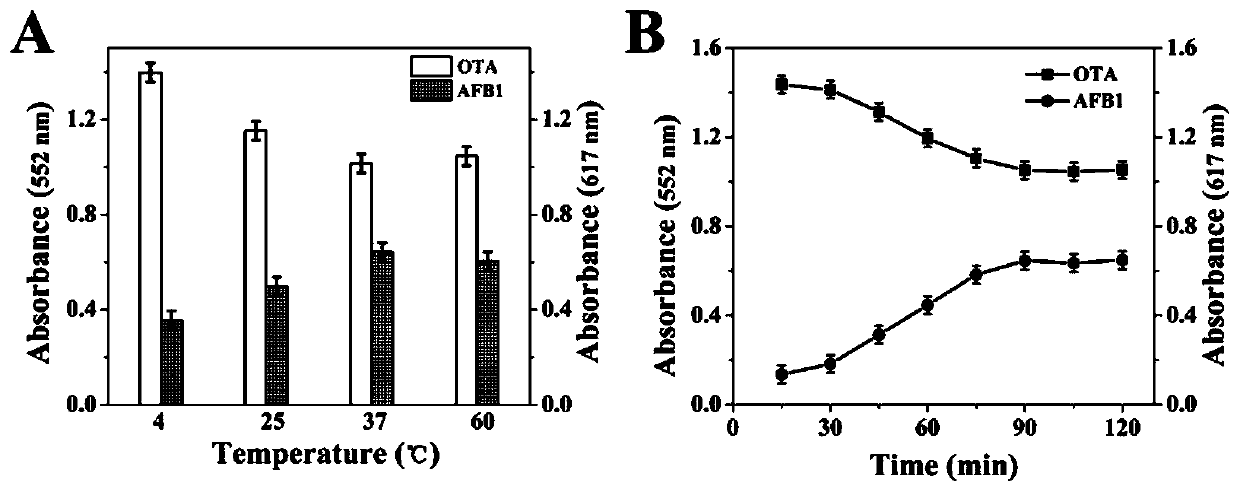A method for constructing a pH-resolving colorimetric biosensor
A biosensor and colorimetric technology, applied in the field of pH-resolution colorimetric biosensors, can solve problems such as global food pollution, adverse effects on humans, animals and crops, diseases and economic losses
- Summary
- Abstract
- Description
- Claims
- Application Information
AI Technical Summary
Problems solved by technology
Method used
Image
Examples
example 1
[0108] 1) Ferric oxide nanoparticles and graphene oxide composite (Fe 3 o 4 / GO) preparation
[0109] First, 50mL graphene oxide aqueous solution (0.8mg / mL) was sonicated for 1h, followed by nitrogen gas for 30min; then, under nitrogen protection, 50mL ferric chloride (0.055g) and ferrous sulfate (0.048g) mixed solution was added dropwise, and stirred for 12h . Stir vigorously, add 6M sodium hydroxide dropwise to the mixture until the pH value reaches 10.0, react at 90°C for 1.5h, and then cool to room temperature. Wash with phosphate buffer with a pH value of 7.4 until neutral, and store at 100 mL at 4°C for later use.
[0110] 2) Colorimetric analysis at different temperatures
[0111] The fixed reaction time is 90min, pipette 1mL PP-DNA respectively 1 -GO-OTA aptamer-DNA 2 -Fe 3 o 4 / GO, MGCB-DNA 3 -GO-AFB1aptamer-DNA 4 -Fe 3 o 4 / GO solution mixed, remove the supernatant after magnetic separation, add 1mL target ochratoxin A (OTA) and aflatoxin B1 (AFB1) mixtur...
example 2
[0113] 1) Ferric oxide nanoparticles and graphene oxide composite (Fe 3 o 4 / GO) preparation
[0114] First, 50mL graphene oxide aqueous solution (0.8mg / mL) was sonicated for 1h, followed by nitrogen gas for 30min; then, under nitrogen protection, 50mL ferric chloride (0.055g) and ferrous sulfate (0.048g) mixed solution was added dropwise, and stirred for 12h . Stir vigorously, add 6M sodium hydroxide dropwise to the mixture until the pH value reaches 10.0, react at 90°C for 1.5h, and then cool to room temperature. Wash with phosphate buffer with a pH value of 7.4 until neutral, and store at 100 mL at 4°C for later use.
[0115] 2) Colorimetric analysis at different times
[0116] The fixed reaction temperature was 37°C. , respectively pipette 1mL PP-DNA 1 -GO-OTA aptamer-DNA 2 -Fe 3 o 4 / GO, MGCB-DNA 3 -GO-AFB1aptamer-DNA 4 -Fe 3 o 4 / GO solution mixed, remove the supernatant after magnetic separation, add 1mL target ochratoxin A (OTA) and aflatoxin B1 (AFB1) mix...
example 3
[0118] 1) Ferric oxide nanoparticles and graphene oxide composite (Fe 3 o 4 / GO) preparation
[0119] First, 50mL graphene oxide aqueous solution (0.8mg / mL) was sonicated for 1h, followed by nitrogen gas for 30min; then, under nitrogen protection, 50mL ferric chloride (0.055g) and ferrous sulfate (0.048g) mixed solution was added dropwise, and stirred for 12h . Stir vigorously, add 6M sodium hydroxide dropwise to the mixture until the pH value reaches 10.0, react at 90°C for 1.5h, and then cool to room temperature. Wash with phosphate buffer with a pH value of 7.4 until neutral, and store at 100 mL at 4°C for later use.
[0120] 2) Colorimetric detection of ochratoxin A (OTA) and aflatoxin B1 (AFB1)
[0121] The fixed reaction temperature was 37 °C and the reaction time was 90 min. , respectively pipette 1mL PP-DNA 1 -GO-OTAaptamer-DNA 2 -Fe 3 o 4 / GO, MGCB-DNA 3 -GO-AFB1aptamer-DNA 4 -Fe 3 o 4 / GO solution was mixed, and after magnetic separation, the supernatant ...
PUM
| Property | Measurement | Unit |
|---|---|---|
| thickness | aaaaa | aaaaa |
| thickness | aaaaa | aaaaa |
Abstract
Description
Claims
Application Information
 Login to View More
Login to View More - R&D
- Intellectual Property
- Life Sciences
- Materials
- Tech Scout
- Unparalleled Data Quality
- Higher Quality Content
- 60% Fewer Hallucinations
Browse by: Latest US Patents, China's latest patents, Technical Efficacy Thesaurus, Application Domain, Technology Topic, Popular Technical Reports.
© 2025 PatSnap. All rights reserved.Legal|Privacy policy|Modern Slavery Act Transparency Statement|Sitemap|About US| Contact US: help@patsnap.com



